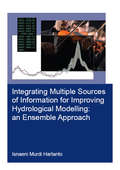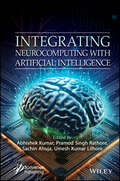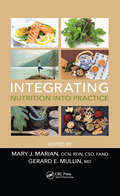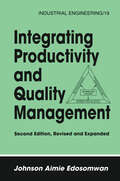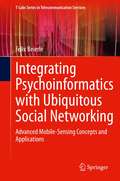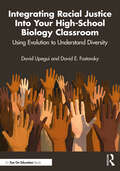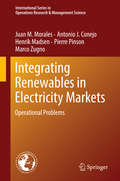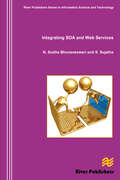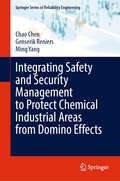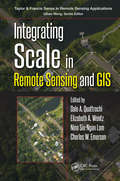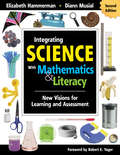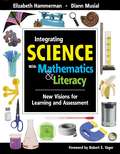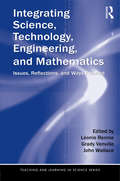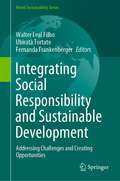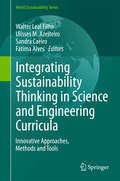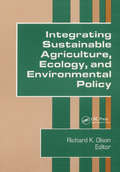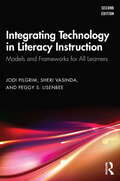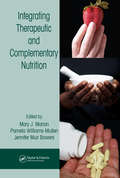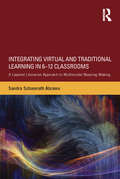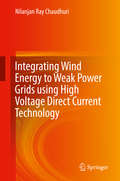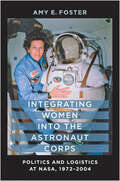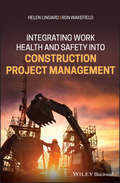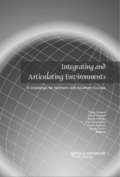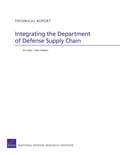- Table View
- List View
Integrating Multiple Sources of Information for Improving Hydrological Modelling: An Ensemble Approach (IHE Delft PhD Thesis Series)
by Isnaeni Murdi HartantoThe availability of Earth observation and numerical weather prediction data for hydrological modelling and water management has increased significantly, creating a situation that today, for the same variable, estimates may be available from two or more sources of information. Yet, in hydrological modelling, usually, a particular set of catchment characteristics and input data is selected, possibly ignoring other relevant data sources. In this thesis, therefore, a framework is being proposed to enable effective use of multiple data sources in hydrological modelling. In this framework, each available data source is used to derive catchment parameter values or input time series. Each unique combination of catchment and input data sources thus leads to a different hydrological simulation result: a new ensemble member. Together, the members form an ensemble of hydrological simulations. By following this approach, all available data sources are used effectively and their information is preserved. The framework also accommodates for applying multiple data-model integration methods, e.g. data assimilation. Each alternative integration method leads to yet another unique simulation result. Case study results for a distributed hydrological model of Rijnland, the Netherlands, show that the framework can be applied effectively, improve discharge simulation, and partially account for parameter and data uncertainty.
Integrating Neurocomputing with Artificial Intelligence
by Abhishek Kumar Pramod Singh Rathore Sachin Ahuja Umesh Kumar LilhoreIntegrating Neurocomputing with Artificial Intelligence provides unparalleled insights into the cutting-edge convergence of neuroscience and computing, enriched with real-world case studies and expert analyses that harness the transformative potential of neurocomputing in various disciplines. Integrating Neurocomputing with Artificial Intelligence is a comprehensive volume that delves into the forefront of the neurocomputing landscape, offering a rich tapestry of insights and cutting-edge innovations. This volume unfolds as a carefully curated collection of research, showcasing multidimensional perspectives on the intersection of neuroscience and computing. Readers can expect a deep exploration of fundamental theories, methodologies, and breakthrough applications that span the spectrum of neurocomputing. Throughout the book, readers will find a wealth of case studies and real-world examples that exemplify how neurocomputing is being harnessed to address complex challenges across different disciplines. Experts and researchers in the field contribute their expertise, presenting in-depth analyses, empirical findings, and forward-looking projections. Integrating Neurocomputing with Artificial Intelligence serves as a gateway to this fascinating domain, offering a comprehensive exploration of neurocomputing’s foundations, contemporary developments, ethical considerations, and future trajectories. It embodies a collective endeavor to drive progress and unlock the potential of neurocomputing, setting the stage for a future where artificial intelligence is not merely artificial, but profoundly inspired by the elegance and efficiency of the human brain.
Integrating Nutrition into Practice
by Gerard E. Mullin Mary J. MarianIntegrative medicine is an approach to wellness that makes use of both conventional and alternative therapies to achieve optimal health and healing. Nutrition-based therapies are consistently among the highest used alternative therapies to treat a wide variety of illnesses. This book provides consumers and health care professionals with practical guidance on integrating nutrition therapies into disease prevention and management. It provides reliable and accurate information from experts in the nutrition field including dietitians, nutritionists, physicians, researchers, and academic professionals.Integrative Nutrition Therapy includes up-to-date information on dietary supplements, popular diets, physical activity, and food allergies. The book covers disease prevention for cancer, cardiovascular disease, diabetes, and obesity. Additional topics include liver/pancreatic conditions and musculoskeletal disorders as well as nutrigenomics, epigenetics, and metabolomics. The book provides evidence-based recommendations for which therapies might be appropriate for various conditions and discusses the possible adverse effects that may develop. It also includes guidelines and suggestions for creating individualized, integrative care plans.Integrative Nutrition Therapy is organized in a systematic manner that presents the scientific data using an evidence-based, how-to approach. An overview of integrative medicine is written by Dr. Roberta Lee, a leading authority in the field. Award-winning nutrition experts provide practical knowledge for the integrative practitioner, covering topics such as: Nutrition screening and assessment Search for the optimum diet Functional foods and nutritional supplements Nutritional recommendations for women’s health Health benefits of physical activity Diet and mental health Although unanswered questions still exist, this resource gives you a much-needed guide to the information currently available on nutrition and lifestyle-based therapies.
Integrating Productivity and Quality Management (Industrial Engineering: A Series of Reference Books and Textboo)
by Johnson EdosomwanThis second edition details all productivity and quality methodologies, principles and techniques, and demonstrates how they interact in the three phases of the productivity and quality management triangle (PQMT): measurement, control and evaluation; planning and analysis; and improvement and monitoring. This edition features material on practical
Integrating Psychoinformatics with Ubiquitous Social Networking: Advanced Mobile-Sensing Concepts and Applications (T-Labs Series in Telecommunication Services)
by Felix BeierleThis book deepens the understanding of people through smartphone data obtained via mobile sensing and applies psychological insights for social networking applications. The author first introduces TYDR, an application for researching smartphone data and user personality. A novel, structured privacy model for mobile sensing applications is developed and the obtained empirical results help researchers gauge what data they can expect users to share in daily-life studies. The new research findings, the concept of mobile sensing, and psychological insights about the formation and structure of real-life social networks are integrated into the field of social networking. Finally, for this novel integration, the author presents concepts, decentralized software architectures, and fully realized prototypes that recommend new contacts, media, and locations to individual users and groups of users.
Integrating Racial Justice Into Your High-School Biology Classroom: Using Evolution to Understand Diversity
by David E. Fastovsky David UpeguiIn this guide, educators and authors David Upegui and David E. Fastovsky offer a pedagogical prescription for how you can integrate the study of racial justice with evolutionary biology in your existing high-school biology curriculum. Designed as a practical manual for teaching, the chapters focus on teaching concepts of equity through evolutionary biology modules, a cornerstone for building students’ scientific understanding of biotic diversity. The book provides pedagogical components alongside historical and scientific components, with contextual chapters that give teachers the background knowledge to understand the historical relationship between science and racism for topics such as natural selection, social justice, and American slavery and colonization. Ready-to-use lesson plans are situated in a historical and theoretical context of science as it relates to racial oppression, and demonstrate how rigorous science education can lead to your students’ liberation and personal empowerment despite the historically problematic history of some applications of science. These lesson plans and classroom exercises are presented in a way that introduces the timely extra dimension of anti-racism into the existing biology curricula without significantly increasing teaching loads. The contextual material provided allows the lessons to be implemented across a variety of classrooms regardless of initial familiarity with DEI. Ideal for secondary biology teachers and their students, particularly in grades 10-12, this book synthesizes timely ideas for high-school educators, harnessing the power of rigorous science to combat marginalization. Lessons and activities have been classroom-tested and are aligned with three different standards: Next Generation Science Standards (NGSS); College board (AP Biology); Vision and Change; and use the 5E format.
Integrating Racial Justice Into Your High-School Biology Classroom: Using Evolution to Understand Diversity
by David E. Fastovsky David UpeguiIn this guide, educators and authors David Upegui and David E. Fastovsky offer a pedagogical prescription for how you can integrate the study of racial justice with evolutionary biology in your existing high-school biology curriculum.Designed as a practical manual for teaching, the chapters focus on teaching concepts of equity through evolutionary biology modules, a cornerstone for building students’ scientific understanding of biotic diversity. The book provides pedagogical components alongside historical and scientific components, with contextual chapters that give teachers the background knowledge to understand the historical relationship between science and racism for topics such as natural selection, social justice, and American slavery and colonization. Ready-to-use lesson plans are situated in a historical and theoretical context of science as it relates to racial oppression, and demonstrate how rigorous science education can lead to your students’ liberation and personal empowerment despite the historically problematic history of some applications of science. These lesson plans and classroom exercises are presented in a way that introduces the timely extra dimension of anti-racism into the existing biology curricula without significantly increasing teaching loads. The contextual material provided allows the lessons to be implemented across a variety of classrooms regardless of initial familiarity with DEI.Ideal for secondary biology teachers and their students, particularly in grades 10-12, this book synthesizes timely ideas for high-school educators, harnessing the power of rigorous science to combat marginalization. Lessons and activities have been classroom-tested and are aligned with three different standards: Next Generation Science Standards (NGSS); College board (AP Biology); Vision and Change; and use the 5E format.
Integrating Renewables in Electricity Markets
by Antonio J. Conejo Juan M. Morales Henrik Madsen Pierre Pinson Marco ZugnoThis addition to the ISOR series addresses the analytics of the operations of electric energy systems with increasing penetration of stochastic renewable production facilities, such as wind- and solar-based generation units. As stochastic renewable production units become ubiquitous throughout electric energy systems, an increasing level of flexible backup provided by non-stochastic units and other system agents is needed if supply security and quality are to be maintained. Within the context above, this book provides up-to-date analytical tools to address challenging operational problems such as: * The modeling and forecasting of stochastic renewable power production. * The characterization of the impact of renewable production on market outcomes. * The clearing of electricity markets with high penetration of stochastic renewable units. * The development of mechanisms to counteract the variability and unpredictability of stochastic renewable units so that supply security is not at risk. * The trading of the electric energy produced by stochastic renewable producers. * The association of a number of electricity production facilities, stochastic and others, to increase their competitive edge in the electricity market. * The development of procedures to enable demand response and to facilitate the integration of stochastic renewable units. This book is written in a modular and tutorial manner and includes many illustrative examples to facilitate its comprehension. It is intended for advanced undergraduate and graduate students in the fields of electric energy systems, applied mathematics and economics. Practitioners in the electric energy sector will benefit as well from the concepts and techniques explained in this book.
Integrating SOA and Web Services
by S. Sujatha N. Sudha BhuvaneswariThis book highlights how to integrate and realize Service Oriented Architecture with web services which is one of the emerging technologies in IT. It also focuses on the latest technologies, such as Metadata Management, Security issues, Quality of Service and its commercialization.
Integrating Safety and Security Management to Protect Chemical Industrial Areas from Domino Effects (Springer Series in Reliability Engineering)
by Ming Yang Genserik Reniers Chao ChenThis book provides insight into domino effects in industrial chemical sites and process industries. It is about the integration of safety and security resources to prevent and mitigate domino effects in the process industries. It explains how chemical industrial areas, comprised of various hazardous installations, are susceptible to a chain of undesired events, or domino effects, triggered by accidental events or intentional attacks and then presents solutions to prevent them. Firstly, the book provides a dynamic graph approach to model the domino effects induced by accidental fire or intentional fire, considering the spatial-temporal evolution of fires. Then, a dynamic risk assessment method based on a discrete dynamic event tree is proposed to assess the likelihood of VCEs and the vulnerability of installations, addressing the time dependencies in vapor cloud dispersion and the uncertainty of delayed ignitions. A dynamic methodology based on dynamic graphs and Monte Carlo is provided to assess the vulnerability of individuals and installations exposed to multi-hazards, such as fire, explosion and toxic release during escalation events. Based on these domino effect models, an economic approach is developed to integrate safe and security resources, obtaining the most cost–benefit protection strategy for preventing domino effects. Finally, a resilience-based approach is provided to find out the most cost-resilient way to protect chemical industrial areas, addressing possible domino effects. This integrated approach will be of interest to researchers, industrial engineers, chemical engineers and safety managers and will help professionals to new solutions in the area of safety and security.
Integrating Scale in Remote Sensing and GIS (Remote Sensing Applications Series)
by Dale A. Quattrochi Elizabeth Wentz Nina Siu-Ngan Lam Charles W. EmersonIntegrating Scale in Remote Sensing and GIS serves as the most comprehensive documentation of the scientific and methodological advances that have taken place in integrating scale and remote sensing data. This work addresses the invariants of scale, the ability to change scale, measures of the impact of scale, scale as a parameter in process models, and the implementation of multiscale approaches as methods and techniques for integrating multiple kinds of remote sensing data collected at varying spatial, temporal, and radiometric scales. Researchers, instructors, and students alike will benefit from a guide that has been pragmatically divided into four thematic groups: scale issues and multiple scaling; physical scale as applied to natural resources; urban scale; and human health/social scale. Teeming with insights that elucidate the significance of scale as a foundation for geographic analysis, this book is a vital resource to those seriously involved in the field of GIScience.
Integrating Science With Mathematics & Literacy: New Visions for Learning and Assessment
by Elizabeth Hammerman Dr Diann L. MusialFeatures tasks that model inquiry-based science and helps teachers evaluate learners' acquisition of complex thinking skills, aptitude for science, and ability to make real-world connections.
Integrating Science with Mathematics & Literacy: New Visions for Learning and Assessment
by Elizabeth Hammerman Diann MusialChallenge and expand students' abilities with multidimensional performance tasks!In this invaluable resource, science educators Elizabeth Hammerman and Diann Musial define a new vision for integrating science, mathematics, and language arts with instruction and assessment and encourage teachers to develop reliable processes for assessing both their teaching practice and student learning.This revised edition offers more than 20 performance assessments that promote student engagement. Each clearly articulated task correlates with current research and focuses on learning indicators linked to state and national standards. The assessments also model inquiry-based science in ways proven to increase student achievement, allowing learners to demonstrate their understanding of embedded concepts through exploration, inquiry, and application.Teachers can follow detailed guidelines to develop customized assessments or use the assessments already included to evaluate learners': Understanding of content and processes Development of complex thinking skills Aptitude for science Ability to make real-world connectionsFeaturing learning logs, portfolios, peer interview strategies, and sample teacher-student interviews, Integrating Science With Mathematics and Literacy, Second Edition, helps educators obtain accurate performance data while giving students opportunities to examine the world in exciting ways.
Integrating Science, Technology, Engineering, and Mathematics: Issues, Reflections, and Ways Forward (Teaching and Learning in Science Series)
by Léonie Rennie, Grady Venville, and John WallaceHow can curriculum integration of school science with the related disciplines of technology, engineering and mathematics (STEM) enhance students’ skills and their ability to link what they learn in school with the world outside the classroom? Featuring actual case studies of teachers’ attempts to integrate their curriculum, their reasons for doing so, how they did it, and their reflections on the outcomes, this book encourages science educators to consider the purposes and potential outcomes of this approach and raises important questions about the place of science in the school curriculum. It takes an honest approach to real issues that arise in curriculum integration in a range of education contexts at the elementary and middle school levels. The clear documentation and critical analysis of the contribution of science in curriculum integration—its implementation and its strengths and weaknesses—will assist teachers, science educators, and researchers to understand how this approach can work to engage students and improve their learning, as well as how it does not happen easily, and how various factors can facilitate or hinder successful integration.
Integrating Social Responsibility and Sustainable Development: Addressing Challenges and Creating Opportunities (World Sustainability Series)
by Walter Leal Filho Fernanda Frankenberger Ubiratã TortatoThis book is a truly interdisciplinary publication, useful to scholars, social movements, practitioners and members of governmental agencies and private companies, undertaking research and/or executing projects focusing on social responsibility and sustainability from across the world.Sustainable development has become a matter of central concern to both public institutions and enterprises. Indeed, for many companies, a due emphasis to environmental issues is not only positive from the point of view of environmental gains, but also to the image of the business. Often, but not always, this is reflected in the preparation of formal strategies and programmes, which entail their institutional strategies and visions. The wide area of social responsibility, often known as Corporate Social Responsibility (CSR), entails elements of social equality and environmental accountability, and eco-efficiency. Due to their complexity, the interrelations between social responsibility and sustainable development need to be better understood. There is also a real need to showcase successful examples of how public institutions and companies are handling their sustainability challenges. It is against this background that this book has been produced.
Integrating Sustainability Thinking in Science and Engineering Curricula
by Walter Leal Filho Sandra Caeiro Ulisses M. Azeiteiro Fátima AlvesIncluding considerations of sustainability in universities' activities has long since become mainstream. However, there is still much to be done with regard to the full integration of sustainability thinking into science and engineering curricula. Among the problems that hinder progress in this field, the lack of sound information on how to actually implement it is prominent. Created in order to address this need, this book presents a wealth of information on innovative approaches, methods and tools that may be helpful in translating sustainability principles into practice.
Integrating Sustainable Agriculture, Ecology, and Environmental Policy
by Richard OlsonFind an interdiscliplinary view of sustainable agriculture that emphasizes the potential contributions of ecology to agricultural sustainability in this groundbreaking book. Integrating Sustainable Agriculture, Ecology, and Environmental Policy explores how ecological knowledge, applied as part of a multidisciplinary effort, can be used to design a sustainable and environmentally sound agriculture. A more ecologically based agriculture can increase production efficiency and decrease environmental impacts, but hard choices regarding population control, energy conservation, and land use must still be made. This interdisciplinary approach ensures that the results are beneficial to all components, for example, an ecologically based management scheme which bankrupts the farmer is not considered a viable option for sustainable agriculture. These thought-provoking chapters are an excellent introduction to the contributions of ecological principles to an environmentally sound sustainable agriculture. This multidisciplinary examination provides readers interested in agriculture with a valuable introduction to related work in other fields including ecology and economics. Agronomists, ecologists, educators, and policymakers will find essential information on diverse topics including: the definition and measurement of ecological sustainability in agriculture landscape ecology and the design of sustainable agricultural landscapes soil ecology as a foundation for sustainable agriculture Federal agricultural policies as incentives or deterrent to sustainable agriculture applying farming systems research and extension to sustainable agriculture population growth and other threats to sustainable agriculture environmental policies and their effects on sustainable agriculture the role of precollege education in developing sustainable agriculture
Integrating Technology in Literacy Instruction: Models and Frameworks for All Learners
by Jodi Pilgrim Sheri Vasinda Peggy S. LisenbeeIn the second edition, this text has been updated to address changing literacies surrounding students and the continued importance of effective communication using technology tools in K-12 classrooms. Technology has the power and potential to transform teaching and learning in classrooms and to promote active learning, interaction, and engagement through readily available tools and applications. While both technologies and research in literacy education rapidly evolve, this book presents lasting frameworks for teachers to effectively evaluate and implement digital tools to enhance classroom literacies and learning. Through the lens of Universal Design for Learning (UDL), this text equips educators to develop inclusive learning environments that support the needs and desires of all literacy learners through the integration of technology and literacy instruction. This text presents a range of current models and frameworks, including SAMR, RAT, PICRAT, T3, TPACK, TIPC, and EMSCI. The new edition of this book has been updated to include: Alignment with ISTE standards in each chapter Updates from the 2024 UDL Guidelines 3.0 Updates from the most recent 2024 National Educational Technology Plan Updated technology applications, including AI and its impact Tools for teaching through remote and distance learning Each chapter includes prompts for reflection and discussion to encourage readers to consider ways literacy and technology can enable teachers to become agents of change. This book will be especially beneficial for pre-service undergraduate and graduate teacher candidates, as well as ISTE certified educators and those seeking certification.
Integrating Therapeutic and Complementary Nutrition
by Jennifer Muir Bowers Mary J. Marian Pamela Williams-MullenConsumers look to health professionals for guidance on how to integrate complementary and alternative (CAM) therapies into their lifestyles, yet most health care professionals are trained only in conventional practices. Integrating Therapeutic and Complementary Nutrition provides the scientific foundation necessary to understand CAM nutrition pract
Integrating Virtual and Traditional Learning in 6-12 Classrooms: A Layered Literacies Approach to Multimodal Meaning Making
by Sandra Schamroth AbramsIntegrating Virtual and Traditional Learning in 6-12 Classrooms introduces a model of "layered literacies" as a framework for describing and illustrating how students’ digital experiences can inform educational methods. Through the lens of layered literacies, educators can envision opportunities to draw upon adolescents’ out-of-school interests and activities to meaningfully integrate digital practices within academic contexts. Such an approach facilitates innovative teaching, inspired learning, and successful pedagogy, and it thoughtfully highlights the role of technology within mandated standards-based instruction in public schools. Combining foundational and contemporary theories, supported by data from multiple studies of adolescent learning, and honoring teachers’ and students’ experiences and resources, this text helps educators reconceptualize the ways students learn through and with digital texts and negotiate the connection between online and offline spaces. A companion website extends the discussion onto the screen, engaging readers in an intertextual approach to learning that complements the concept of layering literacies across disciplines. With a foreword by Jennifer Rowsell and an afterword by Bill Cope and Mary Kalantzis, it will be of interest to experienced educators and administrators, as well as postgraduate, graduate, and undergraduate students of education.
Integrating Wind Energy to Weak Power Grids using High Voltage Direct Current Technology
by Nilanjan Ray ChaudhuriThis book is the first of its kind to provide a comprehensive framework for connecting wind farms to weak power grids using High Voltage DC technology. Most onshore wind energy potential is located in areas that are hardly inhabited and the majority of wind energy that is being harnessed by European countries is currently offshore, both sourced from locations that lack the presence of a strong power grid. This book focuses on the many challenges the wind farm industry faces integrating both onshore and offshore wind to ‘weak’ grids using HVDC technology. Through case studies and illustrative examples the author presents a framework for theoretical and mathematical analysis of HVDC technology, its application and successful integration of onshore and offshore wind farms.Presents a unified approach for integrating onshore and offshore wind energy to existing AC systems through MTDC grids; Includes an extensive treatment of onshore wind farms connected to LCC HVDC systems;Provides a comprehensive analysis of offshore wind farms connected to VSC HVDC systems.
Integrating Women into the Astronaut Corps: Politics and Logistics at NASA, 1972–2004
by Amy E. FosterWhy, Amy E. Foster asks, did it take two decades after the Soviet Union launched its first female cosmonaut for the United States to send its first female astronaut into space? In answering this question, Foster recounts the complicated history of integrating women into NASA’s astronaut corps. NASA selected its first six female astronauts in 1978. Foster examines the political, technological, and cultural challenges that the agency had to overcome to usher in this new era in spaceflight. She shows how NASA had long developed progressive hiring policies but was limited in executing them by a national agenda to beat the Soviets to the moon, budget constraints, and cultural ideas about women’s roles in America. Lively writing and compelling stories, including personal interviews with America’s first women astronauts, propel Foster’s account. Through extensive archival research, Foster also examines NASA’s directives about sexual discrimination, the technological issues in integrating women into the corps, and the popular media’s discussion of women in space. Foster puts together a truly original study of the experiences not only of early women astronauts but also of the managers and engineers who helped launch them into space.In documenting these events, Foster offers a broader understanding of the difficulties in sexually integrating any workplace, even when the organization approaches the situation with as positive an outlook and as strong a motivation as did NASA.
Integrating Work Health and Safety into Construction Project Management
by Helen Lingard Ron WakefieldProvides insights into how health and safety can be more effectively integrated into the procurement, design, and management of construction projects This book aims to explore the ways in which technological, organizational, and cultural strategies can be combined and integrated into construction project management to produce sustained and significant health and safety (H&S) improvements. It looks at design and safety practices, work organization, workforce engagement and learning, and offers ideas for producing systemic change. Integrating Work Health and Safety into Construction Project Management addresses how best to achieve safety in design through the adoption of a stakeholder management approach. It instructs on how to drive H&S improvements through supply chain integration and responsible procurement and project management practices. It examines the components of a culture for health and safety and the development of a cultural maturity model. The book discusses the potential to improve H&S through the provision of conditions of work that afford workers a positive work-life balance. It also covers how advanced technologies and the application of techniques developed from health informatics can support real time analysis and improvement of H&S in construction. Lastly, it looks at the benefits associated with engaging workers and using their tacit H&S knowledge to inform work process improvements. This text also: Provides new and non-traditional ways of thinking about H&S Focuses on technological, organizational, and cultural integration Offers a multi-disciplinary perspective provided by an internationally recognized research team from the social sciences, engineering, construction/project management, and psychology Presents, in detail, the collective analysis from a broad-ranging ten year program of collaborative research Contains a rich range of industry case studies Integrating Work Health and Safety into Construction Project Management is an excellent resource for academics and researchers engaged in research in construction H&S, as well as for postgraduates taking construction project management and H&S courses. It will also be beneficial to consultants, policy advisors, construction project managers and H&S professionals.
Integrating and Articulating Environments
by Fikret Adaman Fatoş Gökşen Ørnulf Seippel Ünal Zenginobuz Jesper GrolinA critical, comparative exploration of the framing of environmental problems in Northern and Southern Europe. The book addresses theoretical and empirical questions about environmental attitudes and behaviours, politics and protest, cultures and contexts.
Integrating the Department of Defense Supply Chain
by Eric Peltz Marc Robbins Geoffrey McgovernThe authors provide a framework for an integrated Department of Defense (DoD) supply chain, associated policy recommendations, and a companion framework for management practices that will drive people to take actions aligned with this integrated supply chain approach. Building on the framework and policy recommendations, they identify opportunities to improve DoD supply chain efficiency and highlight several already being pursued by DoD.
